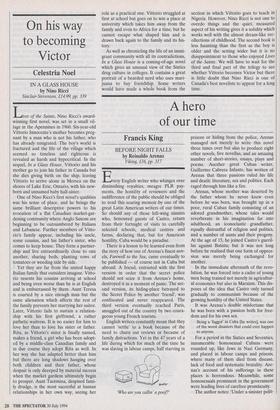On his way to becoming Victor
Celestria Noel
IN A GLASS HOUSE by Nino Ricci Sinclair-Stevenson, £14.99, pp. 339 Lives of the Saints, Nino Ricci's award- winning first novel, was set in a small vil- lage in the Apennines in 1960. Six-year-old Vittorio Innocente's mother becomes preg- nant by a man who is not his father, who has already emigrated. The boy's world is fractured and the life of the village which seemed so timeless and righteous is revealed as harsh and hypocritical. In the sequel, In a Glass House, Vittorio and his mother go to join his father in Canada but she dies giving birth on the ship, leaving Vittorio to arrive alone in Mersea on the shores of Lake Erie, Ontario, with his new- born and unnamed baby half-sister.
One of Nino Ricci's first novel's qualities was his sense of place, and he brings the same brilliant descriptive powers to his evocation of a flat Canadian market-gar- dening community where Anglo Saxons are beginning to be outnumbered by Italians and Lebanese. Further members of Vitto- rio's family appear, including his uncle, some cousins, and his father's sister, who comes to keep house. They form a partner- ship and live extraordinarily close to one another, sharing beds, planting rows of tomatoes or weeding side by side.
I Yet they are far from the united happy Italian family that outsiders imagine. Vitto- rio resents his cousins arriving at school and being even worse than he is at English and is embarrassed by them. Aunt Teresa is courted by a nice enough man but the same alienation which affects the rest of the family prevents her marrying her suitor. Later, Vittorio fails to sustain a relation- ship with his first girlfriend, a rather pathetic waitress. It is no easier for him to love her than to love his sister or father. Rita, as Vittorio's sister is finally named, makes a friend, a girl who has been adopt- ed by a middle-class Canadian family and in due course they adopt Rita as well. In her way she has adapted better than him but there are long shadows hanging over both children and their father, whose despair is only deeeped by material success when the market gardens ultimately begin to prosper. Aunt Taormina, despised fami- ly drudge, is the most succesful at human relationships in her own way, seeing her role as a practical one. Vittorio struggled at first at school but goes on to win a place at university which takes him away from the family and even to Africa for a time, but he cannot escape what shaped him and is drawn back again to the family and its his- tory.
As well as chronicling the life of an immi- grant community with all its contradictions, In a Glass House is a coming-of-age novel which gives an unusual view of the Sixties drug culture in colleges. It contains a great portrait of a bearded nerd who uses mari- juana to buy friendship. Some writers would have made a whole book from the section in which Vittorio goes to teach in Nigeria. However, Nino Ricci is not one to overdo things and the quiet, measured aspect of his writing gives it a solidity which works well with the almost dream-like rec- ollections of childhood. The second book is less haunting than the first as the boy is older and the setting wider but it is no diasppointment to those who enjoyed Lives of the Saints. We will have to wait for the third and final part of the trilogy to see whether Vittorio becomes Victor but there is little doubt that Nino Ricci is one of Canada's best novelists to appear for a long time.


















































 Previous page
Previous page